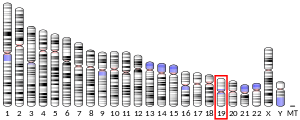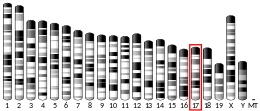MARCH2
E3 ubiquitin-protein ligase MARCH2 is an enzyme that in humans is encoded by the MARCH2 gene.[5][6][7] It is a member of the MARCH family of E3 ligases, and plays an important role in the turnover of membrane proteins.[8]
Gene name error in Excel
Like the other MARCH and septin genes, care must be exercised when analyzing genetic data containing the MARCH2 gene in Microsoft Excel.[9] This is due to Excel's autocorrect feature treating the MARCH gene as a date and converting it to a standard date format. The original text cannot be recovered as a result of the conversion. A 2016 study found up to 19.6% of all papers in selected journals to be affected by the gene name error.[10] The issue can be prevented by using an alias name such as MARCHF2, prepending with an apostrophe ('), or preformatting the cell as text.
References
- GRCh38: Ensembl release 89: ENSG00000099785 - Ensembl, May 2017
- GRCm38: Ensembl release 89: ENSMUSG00000079557 - Ensembl, May 2017
- "Human PubMed Reference:". National Center for Biotechnology Information, U.S. National Library of Medicine.
- "Mouse PubMed Reference:". National Center for Biotechnology Information, U.S. National Library of Medicine.
- Zhang QH, Ye M, Wu XY, Ren SX, Zhao M, Zhao CJ, Fu G, Shen Y, Fan HY, Lu G, Zhong M, Xu XR, Han ZG, Zhang JW, Tao J, Huang QH, Zhou J, Hu GX, Gu J, Chen SJ, Chen Z (October 2000). "Cloning and functional analysis of cDNAs with open reading frames for 300 previously undefined genes expressed in CD34+ hematopoietic stem/progenitor cells". Genome Research. 10 (10): 1546–60. doi:10.1101/gr.140200. PMC 310934. PMID 11042152.
- Bartee E, Mansouri M, Hovey Nerenberg BT, Gouveia K, Früh K (February 2004). "Downregulation of major histocompatibility complex class I by human ubiquitin ligases related to viral immune evasion proteins". Journal of Virology. 78 (3): 1109–20. doi:10.1128/JVI.78.3.1109-1120.2004. PMC 321412. PMID 14722266.
- "Entrez Gene: MARCH2 membrane-associated ring finger (C3HC4) 2".
- Zhang Y, Lu J, Liu X (May 2018). "MARCH2 is upregulated in HIV-1 infection and inhibits HIV-1 production through envelope protein translocation or degradation". Virology. 518: 293–300. doi:10.1016/j.virol.2018.02.003. PMID 29573664.
- Zeeberg BR, Riss J, Kane DW, Bussey KJ, Uchio E, Linehan WM, et al. (June 2004). "Mistaken identifiers: gene name errors can be introduced inadvertently when using Excel in bioinformatics". BMC Bioinformatics. 5 (1): 80. doi:10.1186/1471-2105-5-80. PMC 459209. PMID 15214961.
- Ziemann M, Eren Y, El-Osta A (August 2016). "Gene name errors are widespread in the scientific literature". Genome Biology. 17 (1): 177. doi:10.1186/s13059-016-1044-7. PMC 4994289. PMID 27552985.
Further reading
- Andersson B, Wentland MA, Ricafrente JY, Liu W, Gibbs RA (April 1996). "A "double adaptor" method for improved shotgun library construction". Analytical Biochemistry. 236 (1): 107–13. doi:10.1006/abio.1996.0138. PMID 8619474.
- Yu W, Andersson B, Worley KC, Muzny DM, Ding Y, Liu W, Ricafrente JY, Wentland MA, Lennon G, Gibbs RA (April 1997). "Large-scale concatenation cDNA sequencing". Genome Research. 7 (4): 353–8. doi:10.1101/gr.7.4.353. PMC 139146. PMID 9110174.
- Brandenberger R, Wei H, Zhang S, Lei S, Murage J, Fisk GJ, Li Y, Xu C, Fang R, Guegler K, Rao MS, Mandalam R, Lebkowski J, Stanton LW (June 2004). "Transcriptome characterization elucidates signaling networks that control human ES cell growth and differentiation". Nature Biotechnology. 22 (6): 707–16. doi:10.1038/nbt971. PMID 15146197.
- Nakamura N, Fukuda H, Kato A, Hirose S (April 2005). "MARCH-II is a syntaxin-6-binding protein involved in endosomal trafficking". Molecular Biology of the Cell. 16 (4): 1696–710. doi:10.1091/mbc.E04-03-0216. PMC 1073653. PMID 15689499.
- Fukuda H, Nakamura N, Hirose S (January 2006). "MARCH-III Is a novel component of endosomes with properties similar to those of MARCH-II". Journal of Biochemistry. 139 (1): 137–45. doi:10.1093/jb/mvj012. PMID 16428329.




